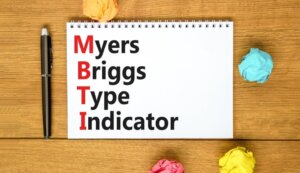Myers & Briggs: Two Housewives Who Changed Psychology


Reviewed and approved by the psychologist Sergio De Dios González
If we mention Myers & Briggs, chances are you may not know who we’re talking about. On the other hand, if we mentioned the MBTI, you’d probably recognize this as the acronym for one of the most famous personality assessment tests.
In fact, the MBTI is one of the most widely used personality tests in the world. This is despite the fact that many consider it to be invalid since they believe it isn’t supported by sufficient scientific evidence. However, this instrument, designed by Myers & Briggs, has been studied in detail and there’s certain evidence of its validity.
Behind this popular test, lies a really interesting story. Myers & Briggs were the last names of a mother and daughter. They were two housewives who, although they weren’t psychologists, designed the evaluation a long time ago. They didn’t imagine that, decades later, the instrument would be used by multiple organizations around the world.
“Briggs and Myers were among the first to perceive how hungry the masses were for simple answers to the problem of self-knowledge.”
-Merve Emre-
Myers & Briggs
Myers & Briggs refers to Isabel Myers and Katharine Briggs. They were daughter and mother, respectively. The story begins with Katharine, a woman born in the United States in 1875. She was intellectually curious. In fact, she came from a family of academics and soon demonstrated a great inclination toward studying and reading.
However, at the time, it was believed that intellectual activity could damage a woman’s reproductive capacity. Despite this fact, Katharine educated herself, went to college, and earned a degree in agriculture. Later, she became a teacher. But, she was expected simply to marry and have children.
Eventually, she did marry a physicist named Lyman Briggs. He supported his wife’s intellectual adventures. She even had a room in the house as her study. Isabel was their only daughter and became the ‘object’ of her mother’s investigation.

A laboratory at home
The birth of Isabel gave rise to the duo Myers & Briggs. Katharine thought it was a good idea to start a research lab in her own home with her own daughter. She called it the Cosmic Laboratory of Baby Training.
Katharine thought that parenting could be scientifically supported and allowed herself to conduct ‘little experiments’ with her daughter. She particularly dedicated herself to observing Isabel’s behaviors. The result of this was the Diary of an Obedience-Curiosity Model. There, she wrote down her daughter’s reactions to certain stimuli, illustrating how she managed to make her little girl obedient and curious at the same time.
Her intellectual restlessness led her to discover the book Psychological Types, by Carl Jung. From that moment on, it became a reference for her. In addition, she established correspondence with Jung himself. After five years of study, Myers considered it’d be worthwhile to develop a questionnaire so people could identify their personality types according to Jung’s theory. She put her plan into action.

Isabel and the continuation of the work
Meanwhile, Isabel demonstrated similar gifts to those of her mother. She was a born researcher. She studied Political Science in college, but, like Katharine, it wasn’t long before she decided to get married. Also, like her mother, marriage was no obstacle to her intellectual concerns.
In fact, Isabel continued with the work that her mother had started. She finished shaping the MBTI or Myers & Briggs Type Indicator. It was based on the personality types established by Carl Jung. Isabel contributed her own observations to the questionnaire.
The young woman thought that the test would work better if it alluded to everyday situations so that people could identify themselves more easily. From then on, the questionnaire started to become popular. Isabel was also extremely interested in writing fiction. As a matter of fact, the MBTI helped her shape one of her characters in a novel that she published in 1929.
The MBTI or Myers & Briggs Type Indicator began to be used by intelligence personnel in the United States. Subsequently, many companies started to use it, as did several universities. Today, various organizations continue to use the instrument, yet few know the history behind it.
If we mention Myers & Briggs, chances are you may not know who we’re talking about. On the other hand, if we mentioned the MBTI, you’d probably recognize this as the acronym for one of the most famous personality assessment tests.
In fact, the MBTI is one of the most widely used personality tests in the world. This is despite the fact that many consider it to be invalid since they believe it isn’t supported by sufficient scientific evidence. However, this instrument, designed by Myers & Briggs, has been studied in detail and there’s certain evidence of its validity.
Behind this popular test, lies a really interesting story. Myers & Briggs were the last names of a mother and daughter. They were two housewives who, although they weren’t psychologists, designed the evaluation a long time ago. They didn’t imagine that, decades later, the instrument would be used by multiple organizations around the world.
“Briggs and Myers were among the first to perceive how hungry the masses were for simple answers to the problem of self-knowledge.”
-Merve Emre-
Myers & Briggs
Myers & Briggs refers to Isabel Myers and Katharine Briggs. They were daughter and mother, respectively. The story begins with Katharine, a woman born in the United States in 1875. She was intellectually curious. In fact, she came from a family of academics and soon demonstrated a great inclination toward studying and reading.
However, at the time, it was believed that intellectual activity could damage a woman’s reproductive capacity. Despite this fact, Katharine educated herself, went to college, and earned a degree in agriculture. Later, she became a teacher. But, she was expected simply to marry and have children.
Eventually, she did marry a physicist named Lyman Briggs. He supported his wife’s intellectual adventures. She even had a room in the house as her study. Isabel was their only daughter and became the ‘object’ of her mother’s investigation.

A laboratory at home
The birth of Isabel gave rise to the duo Myers & Briggs. Katharine thought it was a good idea to start a research lab in her own home with her own daughter. She called it the Cosmic Laboratory of Baby Training.
Katharine thought that parenting could be scientifically supported and allowed herself to conduct ‘little experiments’ with her daughter. She particularly dedicated herself to observing Isabel’s behaviors. The result of this was the Diary of an Obedience-Curiosity Model. There, she wrote down her daughter’s reactions to certain stimuli, illustrating how she managed to make her little girl obedient and curious at the same time.
Her intellectual restlessness led her to discover the book Psychological Types, by Carl Jung. From that moment on, it became a reference for her. In addition, she established correspondence with Jung himself. After five years of study, Myers considered it’d be worthwhile to develop a questionnaire so people could identify their personality types according to Jung’s theory. She put her plan into action.

Isabel and the continuation of the work
Meanwhile, Isabel demonstrated similar gifts to those of her mother. She was a born researcher. She studied Political Science in college, but, like Katharine, it wasn’t long before she decided to get married. Also, like her mother, marriage was no obstacle to her intellectual concerns.
In fact, Isabel continued with the work that her mother had started. She finished shaping the MBTI or Myers & Briggs Type Indicator. It was based on the personality types established by Carl Jung. Isabel contributed her own observations to the questionnaire.
The young woman thought that the test would work better if it alluded to everyday situations so that people could identify themselves more easily. From then on, the questionnaire started to become popular. Isabel was also extremely interested in writing fiction. As a matter of fact, the MBTI helped her shape one of her characters in a novel that she published in 1929.
The MBTI or Myers & Briggs Type Indicator began to be used by intelligence personnel in the United States. Subsequently, many companies started to use it, as did several universities. Today, various organizations continue to use the instrument, yet few know the history behind it.
All cited sources were thoroughly reviewed by our team to ensure their quality, reliability, currency, and validity. The bibliography of this article was considered reliable and of academic or scientific accuracy.
- Jorge, E., González, MC. (2017). Estilos de crianza parental: una revisión teórica. Informes Psicológicos, 17(2), 39-66. https://dialnet.unirioja.es/servlet/articulo?codigo=7044268
- Olivera, L. Logos. (2007). La aventura intelectual de Kant. Sobre la fundamentación de la metafísica y de la ley moral. Logos: Anales des Seminario de Metafísica, 40, 396-399. https://www.proquest.com/openview/aeeaba2cc7dc7b660c125eb64dc054d7/1?pq-origsite=gscholar&cbl=54573
- Quenk, N. L. (2009). Essentials of Myers-Briggs type indicator assessment. John Wiley & Sons.
This text is provided for informational purposes only and does not replace consultation with a professional. If in doubt, consult your specialist.







